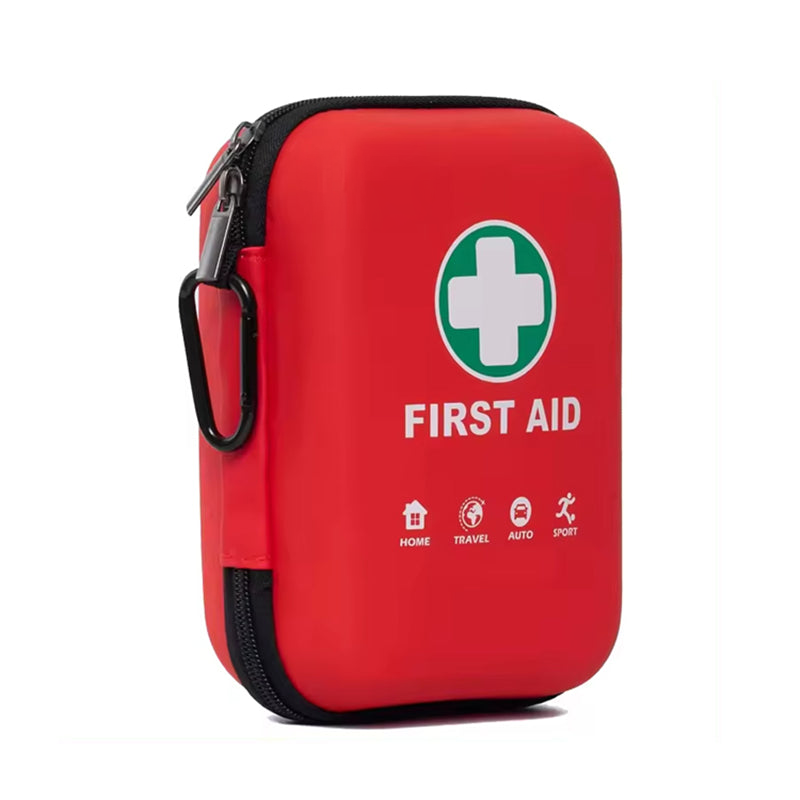Emergency Medical Equipment in Car First Aid Kits

Introduction: How Emergency Medical Equipment in Car First Aid Kits Helps Handle Sudden Medical Issues Inside the Car
Whether on long road trips or short commutes, accidents and sudden medical conditions can strike unexpectedly during daily driving. Car space is limited, and emergency medical help may not arrive immediately.
In these moments, the emergency medical equipment in a car first aid kit becomes the first line of defense for life safety. These tools can address minor injuries like cuts or headaches and, crucially, help manage severe conditions like respiratory failure, cardiac arrest, or massive bleeding, buying precious time until professional help arrives.
The value of a car first aid kit lies in its ability to bring professional medical tools into the hands of ordinary people. By using them correctly and promptly, individuals can minimize harm and even save lives. So, what exactly are these emergency medical supplies, and how do they work in critical moments? Let’s take a closer look.
Overview of Medical Equipment: Portable Respirators, Emergency Hemostatic Kits, AEDs, and More
A car first aid kit contains more than just gauze and band-aids. It features a variety of medical tools designed for emergencies. Here are three core pieces of equipment:
1. Portable Respirator
A portable respirator is a compact, manual device designed to provide emergency support for patients experiencing breathing difficulties or respiratory failure.
It typically consists of a mask and a manual pump mechanism, allowing the operator to deliver oxygen into the patient's lungs with each pump.
This device can be used in various emergency situations, such as asthma attacks, allergic reactions, heart disease-related respiratory arrest, or chest trauma from car accidents.
Despite its small size, the portable respirator can sustain the patient's vital signs before professional help arrives, making it a "breathing guardian" in a car first aid kit.
2. Emergency Hemostatic Kit
In accidents like car crashes, significant bleeding is a common and often fatal threat. The emergency hemostatic kit is specifically designed to address this, containing items like tourniquets, hemostatic powder, hemostatic sponges, and sterile dressings.
A tourniquet can be applied to stop bleeding from severe limb injuries, while hemostatic powder and sponges work directly on the wound to promote clotting.
Sterile dressings protect the wound from infection. These tools come together to form an efficient bleeding control system, providing valuable time for medical intervention.
3. Automated External Defibrillator (AED)
Cardiac arrest is one of the most critical emergencies inside a vehicle, potentially caused by heart attacks, sudden death syndromes, or severe trauma.
An Automated External Defibrillator (AED) is a portable electronic device that can detect a patient's heart rhythm and deliver an electric shock if necessary to restore normal heart function.
AEDs are designed to be user-friendly, with voice prompts that guide even non-medical users through the process, making them a "life-saving tool" in cases of cardiac arrest.
In addition to these three core pieces of equipment, a car first aid kit may also include basic medical supplies such as thermometers, blood pressure cuffs, glucose meters, and common medications (e.g., antihistamines, painkillers) to meet various emergency needs. Together, these items create a comprehensive emergency medical system.
How to Use These Medical Supplies: Dealing with Respiratory Failure, Cardiac Arrest, and Other Emergencies
Having the equipment is just the first step. Knowing how to use it correctly is crucial. Below are detailed instructions for dealing with different emergencies:
1. Using a Portable Respirator for Respiratory Failure
Respiratory failure can manifest as rapid breathing, blue lips, or altered consciousness. If this occurs, use the portable respirator as follows:
-
Step 1: Adjust the Position
Lay the patient flat with their head slightly tilted backward to keep the airway open. If the patient is at risk of vomiting, tilt their head to one side. -
Step 2: Fit the Mask
Place the respirator’s mask snugly over the patient's nose and mouth, ensuring no air leaks. You can gently press around the edges to check the seal. -
Step 3: Pump Oxygen
Gently pump the device at a rate of 12-20 times per minute (for adults; faster for children), ensuring slight chest rise with each compression. Avoid pressing too hard to prevent lung injury. -
Important Notes
Continuously monitor the patient's chest rise and level of consciousness. If the patient regains normal breathing, stop using the respirator and wait for emergency services.
For example, if a passenger experiences difficulty breathing due to an allergic reaction, using a portable respirator can help maintain their oxygen levels and prevent worsening conditions.
2. Using the Emergency Hemostatic Kit for Severe Bleeding
Severe bleeding may occur after a car accident, especially from open wounds or arterial rupture. Here’s how to use the emergency hemostatic kit:
-
Step 1: Assess the Injury
Quickly evaluate the bleeding's location and severity. For major limb bleeding, use the tourniquet first. For torso injuries, apply hemostatic powder or sponges. -
Step 2: Apply the Tourniquet
Place the tourniquet 5-10 cm above the wound, tightening it until the bleeding stops. Record the time of application to avoid leaving it on too long, as this could cause tissue damage. -
Step 3: Use Hemostatic Powder/Sponges
Apply the hemostatic powder to the wound, or press the hemostatic sponge over the bleeding site. Hold pressure for 2-3 minutes until blood coagulates. -
Step 4: Protect the Wound
Cover the wound with sterile dressing and secure it with a bandage, keeping it clean. -
Important Notes
Avoid moving the patient too much to prevent further injury and call for medical help immediately.
For instance, if a car accident causes a passenger’s femoral artery to rupture, applying a tourniquet can stop the bleeding within seconds, providing critical time for rescue operations.
3. Using an AED for Cardiac Arrest
In cardiac arrest, a patient will suddenly lose consciousness, stop breathing, and have no pulse. The steps for using an AED are:
-
Step 1: Ensure Safety
Lay the patient on a flat surface, and ensure no water or metal objects are nearby to prevent electric shock hazards. -
Step 2: Turn on the AED
Open the device and follow the voice prompts. Typically, you’ll need to remove the electrode pads from their packaging and place them on the patient’s chest (one on the upper right chest and one on the lower left side). -
Step 3: Analyze the Heart Rhythm
The AED will automatically analyze the patient’s heart rhythm. Do not touch the patient while it is doing this. -
Step 4: Deliver the Shock
If the AED advises a shock, press the shock button after loudly warning "Clear!" to ensure no one is touching the patient. After the shock, immediately begin CPR. -
Important Notes
If the patient does not regain a heartbeat, repeat the analysis and shock cycle until emergency services arrive.
For example, if a driver experiences cardiac arrest, using the AED and restoring their heartbeat within three minutes could be the difference between life and death.
Conclusion: How Emergency Medical Equipment Helps Handle Critical Conditions in Car Emergencies
Emergency medical equipment in car first aid kits, such as portable respirators, emergency hemostatic kits, and AEDs, are powerful tools for dealing with sudden medical conditions and injuries inside the vehicle.
They target life-threatening situations such as respiratory failure, severe bleeding, and cardiac arrest, providing fast and effective interventions.
With these supplies, ordinary people can act as “first responders” in critical moments, extending survival chances until professional help arrives.
However, having the equipment alone is not enough; its effectiveness depends on the user’s knowledge and skills. Regular first aid training, including CPR, bleeding control, and AED operation, is essential to ensure these tools are used correctly.
Additionally, regular checks and updates to the first aid kit are crucial to keep the equipment in good working condition, ensuring that medications are not expired and devices are functioning properly.
In conclusion, a car first aid kit is not just a "safety standard" in the vehicle, but a guardian of life. Whether dealing with sudden illness or an accident, these emergency medical supplies can buy critical time and protect life.
With proper preparation and training, these tools will become a strong ally in crisis, safeguarding every journey you take. Let’s start prioritizing car first aid kits now, adding an extra layer of protection for both ourselves and others!
